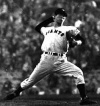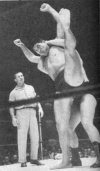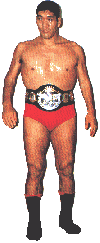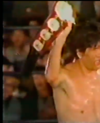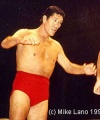Giant Baba
| Giant Baba | |||||||||||||||||||||||||||||
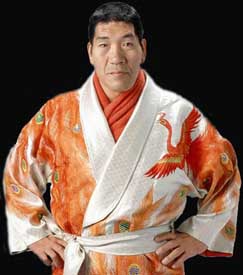 |
|
||||||||||||||||||||||||||||
| Wrestling Observer Hall Of Fame Member |
|---|
Career
Before entering professional wrestling he had been a professional baseball pitcher for the Yomiuri Giants. It was around this time when national wrestling hero Mitsuhiro Momota Sr. (owner of the Japanese Wrestling Association, who competed as Rikidozan) believed that he needed to start grooming a successor in order to keep business strong. In April 1960, Baba began training in Rikidozan's dojo along with fellow student Antonio Inoki. The two trained together under Rikidozan and made their debuts on September 30th, 1960 at the old Daito Ku Gymnasium in Tokyo, where Baba beat Yonetaro Tanaka and Inoki lost to Korean star (and fellow student) Kintaro Oki. The period between 1967 and 1971 is mostly revered by Japanese wrestling fans for Baba and Inoki teaming up to win the NWA International Tag Team Titles; the duo won the titles on October 31st, 1967 after defeating Bill Watts and Tarzan Tyler, and would go on to hold the belts four times. Baba would later break the record with his new partner, Jumbo Tsuruta.
Several months after Inoki had formed New Japan Pro Wrestling and with JWA on the decline, Baba left the promotion in October 1972 to form All Japan Pro Wrestling. The promotion had the backing of Nippon TV and eventually replaced the JWA's membership (following its collapse) in the National Wrestling Alliance. Baba became the first Japanese wrestler to ever hold the NWA World Heavyweight Championship, defeating Jack Brisco in a best 2/3 falls match on December 2, 1974 in Kagoshima, Japan. He would hold the championship on two more occassions, but his reigns were short and limited to Japanese territory. Baba was also the first former NWA World Champion to be defeated by Ric Flair, as Flair was becoming a top contender for the title.
By 1984, Baba began phasing himself out of the main event picture, in order to elevate the next generation of wrestlers, who were led by Jumbo Tsuruta and Genichiro Tenryu. He voluntarily became a "curtain jerker", as he moved slowly and only won against mid-card talent. Under his leadership, All Japan Pro Wrestling became the number one wrestling company in the world during the 1990s. Following the formation of the SWS (Super World Sports), Tenryu, Hara and Great Kabuki left All Japan and Baba was forced to quickly elevate younger talent such as Toshiaki Kawada, Kenta Kobashi, Akira Taue and Tsuyoshi Kikuchi up the card. The biggest move Baba made at this time was taking the mask off Tiger Mask II and giving Mitsuharu Misawa the push as the biggest new singles star, which began with Misawa's pinfall victory over Jumbo Tsuruta in one of the most emotional matches in company history on June 8, 1990 at Budokan Hall; the show was close to a sellout and Misawa was immediately catapulted to main event status due to his victory over the legend. Budokan Hall would became the hotbed of pro wrestling with a string of sellouts in the building lasting for several years, which validated Baba's insistance on clean finishes in matches. With the Triple Crown Championship as the focal point, All Japan sold out more than 250 consecutive shows in Tokyo throughout the early the mid 1990s, routinely drawing houses in the $1,000,000 range eight times a year at Budokan Hall. At the peak of the company, tickets for the next Budokan show would be sold at the live event and completely sell out that night. Baba finally agreed to run the Tokyo Dome and despite it being a few years since the company peaked they still drew 58,300 paid fans.
Baba's last "comeback" was during the World's Strongest Tag League in 1993, when he teamed with old rival Stan Hansen in hopes of winning the Double Cup. The duo made it to the finals, but were defeated by Mitsuharu Misawa and Kenta Kobashi. His final match occurred in 1998, prior to being confined to a hospital bed. On 22 January, 1999, Baba saw his last wrestling match, as Toshiaki Kawada defeated Mitsuharu Misawa for the Triple Crown Championship. Nine days later, Baba died of cancer, a mere week after celebrating his 61st birthday.
Gallery
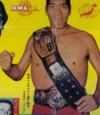 as NWA World
Heavyweight Champ & PWF Heavyweight Champ |
